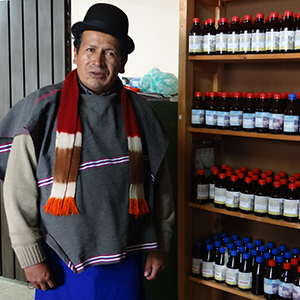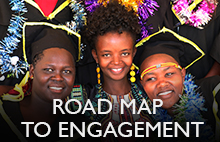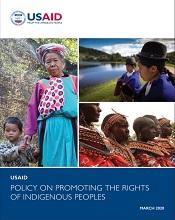
USAID’s Policy on Promoting the Rights of Indigenous Peoples (PRO-IP) guides development practitioners to strengthen the design and management of programs that affect Indigenous Peoples. By considering the ways that project design and activities may impact cultures, territories, resources, and/or livelihoods, the PRO-IP promotes thoughtful and direct engagement of Indigenous Peoples in the design, implementation and monitoring of projects to ensure the communities benefit, and that those benefits are in line with the communities’ self-determined development objectives. These efforts should contribute to deepening the impact of activities and creating more sustainable outcomes by effectively and appropriately partnering with Indigenous Peoples and addressing their challenges throughout the program cycle.
Making the Case for Engagement
Indigenous Peoples number over 370 million across the world. Indigenous Peoples inhabit 20 percent of the earth’s territory, acting as stewards of a wide range of critical ecosystem and for much of the planet’s biological diversity. These communities are sources of knowledge about traditional resource management strategies that are sustainable and about livelihoods that are compatible with the conservation of some of the earth’s most vulnerable ecosystems. Indigenous Peoples' knowledge systems hold the potential to contribute solutions to global health and food security challenges, and Indigenous Peoples’ support for climate change mitigation and adaptation is already well documented.
Despite these strengths, Indigenous Peoples remain among the world’s most marginalized populations, and often face systematic exclusion from their nation's social, economic, and political systems. Meaningful engagement of Indigenous Peoples as partners in the development process is an essential part of conflict management and resolution, enhancing governance and human rights, reducing poverty, and sustainable environmental management. Where Indigenous Peoples are potentially impacted by development activities, practitioners and implementing partners should address the challenges and disadvantages faced by the communities, and work with them through their own representative institutions, so that their contributions may help achieve development objectives.
PRO-IP Objectives
The goal of PRO-IP is to improve the impact and sustainability of development programs by ensuring that they respect Indigenous Peoples’ rights and engage Indigenous Peoples as partners in development processes. In order to advance this goal, PRO-IP has four objectives:
Objective I
Strengthen engagement with Indigenous Peoples to safeguard against harm and support their development priorities and self-reliance
National and sub-national governments, as well as private sector businesses, often fail to account for internal priority setting by Indigenous Peoples' communities. Failing to account for the priorities of Indigenous Peoples often results in conflict, land grabbing, and destruction of livelihoods, while at the same time missing opportunities to access a wealth of traditional knowledge relevant to development objectives.
The PRO-IP provides an improved approach to program design, implementation and monitoring that puts Indigenous Peoples at the center of the management process. This objective promotes enhanced two-way communication between Indigenous Peoples and development practitioners through consultations that are culturally appropriate, rights-based, and which continue over the life of the program. It is critical to first listen to the voices of Indigenous Peoples and then to identify shared or diverging goals for a development activity in order to reach consensus on development objectives and approaches to achieving them.
In addition, this objective seeks to better safeguard against the risk of doing unintended harm by ensuring that USAID’s operating units understand and recognize Indigenous Peoples’ rights, and that Operating Units have increased capacity to design programs that enhance respect and recognition for those rights. Partnerships, consultation processes, and participatory Social Impact Assessments that incorporate regular consultation allow communities to play an active role in identifying and mitigating potential adverse impacts.
Objective II
Increase the integration of Indigenous Peoples’ concerns across all sectors of USAID's portfolio of investments and promote cross-sectoral development approaches
 The intractable development challenges Indigenous Peoples face are the result of a confluence of factors often related to geographic isolation, linguistic barriers, structural and other forms of discrimination or social stigmatization, and historical and ongoing imposition of large-scale development projects that infringe on their rights and negatively impact their livelihoods. Achieving multidimensional improvements in the welfare and well-being of Indigenous Peoples requires a deeper understanding of the interconnection between these drivers of marginalization and the establishment of dedicated programs that take a systems approach to analyzing and addressing them. Dedicated activities consider multiple issues that serve as barriers to empowerment and well-being, including access to economic opportunities and government services, the government's capacity to support Indigenous Peoples’ communities, and awareness-raising of the value of ethnic diversity.
The intractable development challenges Indigenous Peoples face are the result of a confluence of factors often related to geographic isolation, linguistic barriers, structural and other forms of discrimination or social stigmatization, and historical and ongoing imposition of large-scale development projects that infringe on their rights and negatively impact their livelihoods. Achieving multidimensional improvements in the welfare and well-being of Indigenous Peoples requires a deeper understanding of the interconnection between these drivers of marginalization and the establishment of dedicated programs that take a systems approach to analyzing and addressing them. Dedicated activities consider multiple issues that serve as barriers to empowerment and well-being, including access to economic opportunities and government services, the government's capacity to support Indigenous Peoples’ communities, and awareness-raising of the value of ethnic diversity.
Objective III
Empower Indigenous Peoples and their representative organizations to advocate for, and exercise, their rights and practice self-determined development
This objective elevates empowerment of Indigenous Peoples and their representative organizations to a stand-alone objective. It focuses on strengthening the technical expertise and programmatic and financial management skills of Indigenous Peoples’ communities and organizations so they can be more effective at implementing their own development activities. Empowerment is achieved when Indigenous Peoples have secure land and resource rights and acquire the power to act freely, exercise their rights, and advance their own development priorities as full and equal members of society.
Objective IV
Foster an enabling environment for Indigenous Peoples to advocate for and exercise their rights
Indigenous Peoples’ communities often face cultural, social, and institutional barriers to the realization of their rights. This objective aims to ensure that the political, economic, and social systems that shape Indigenous Peoples’ development journeys are more equitable, inclusive, and accessible. USAID should use its convening power to bring together Indigenous Peoples, host-country governments, the private sector, and civil society to remove barriers to the realization of Indigenous Peoples’ rights, promote adherence to international human rights standards, and improve the capacity of host-country governments to engage Indigenous Peoples as partners in the Journey to Self-Reliance.
PRO-IP Operating Principles
Five operating principles, or actionable steps, have been developed in order to achieve the four objectives of the PRO-IP. These five principles – identify, analyze, engage, safeguard, and partner – are to be integrated across the program cycle.
Identify
Identify Indigenous Peoples
The PRO-IP establishes a list of criteria for identifying Indigenous Peoples in areas where we work. This discovery process is further supported by conversations with anthropologists, Indigenous Peoples’ leadership and institutions, and other subject matter experts for additional guidance and local context.
Stakeholder identification should include those people that are impacted, whether positively or negatively, by development outcomes, or whom may have an interest in or influence on development outcomes. The PRO-IP applies to all countries and context in which Indigenous Peoples are identified, including those who governments and legal systems do not recognize formally Indigenous Peoples who live within their boundaries.
Analyze
Analyze Indigenous Peoples’ Opportunities and Challenges
The PRO-IP supports a two-pronged analysis in a given context to determine: 1. how and when during the Program Cycle to engage Indigenous Peoples, and 2. which issues, development objectives, projects, and/or activities are the most relevant for Indigenous Peoples.
In support of Objective II, assessments should focus across sectors to assist (Missions and development practitioners) in identifying systemic and cross-sectoral approaches to addressing complex challenges faced by Indigenous Peoples.
Engage
Engage Indigenous Peoples
This operating principle supports the advancement of Objective I through the direct engagement of Indigenous Peoples on their priorities, capacities, and preferred approaches. A critical first step in this process is establishing or reinforcing two-way lines of communication. As part of this communication and engagement, a number of key considerations should be incorporated:
- Informal engagement should be supplemented with formal consultations throughout the program cycle. This engagement should adhere to standards for community engagement, whether to those established by USAID or by another reputable development organization.
- Engagement activities should also establish a climate of mutual trust in order to promote consultations conducted in good faith. This can be done by establishing procedural steps or “rules of engagement” for the ongoing consultation process.
- Consultations should be able to serve as pivot points to influence and redirect program design if it no longer aligns with the priorities of Indigenous Peoples.
Ultimately, the process of engagement and consultation should facilitate mutual understanding about program design, objectives, and activities. This helps implementing partners and potentially impacted communities identify potential impacts and consider risk mitigation approaches.
Safeguard
Safeguard Indigenous Peoples’ Rights and Well-being
Safeguarding the rights and well-being of Indigenous Peoples throughout the program cycle can be approached through three key steps:
- In coordination with Indigenous organizations and communities, identify potential adverse impacts during stakeholder engagement, consultancies, Inclusive Development Analyses, and Social Impact Assessments.
- Work with Indigenous Peoples' organizations and communities to identify ways to minimize or mitigate identified risks. These risk mitigation measures should be documented within the social impact assessment.
- If there are risks of adverse impacts on the rights, livelihoods, cultures, lands and territories, natural resources, or sacred sites, or if there is relocation as a result of program activities, free, prior and informed consent (FPIC) should be sought for those activities. FPIC should be obtained in line with agreed-upon decision making processes and institutions, and should be clear and documented, whether by written or oral means, working to ensure that steps are taken that enable sub-groups to express their preferences.
Partner
Establish Partnerships with Indigenous Peopleswomen at lake
This operating principle promotes local ownership and development approaches through partnership and co-creation with Indigenous Peoples. Partnerships can, and should, extend through all phases of USAID’s program and project design. For example, this could include the development of a methodology for a Social Impact Assessment, an Inclusive Development Analysis, the design of the consultation process and procedures, or drafting or program descriptions. This principle is focused on treating Indigenous People as the development experts that they are, and allowing traditional knowledge to be incorporated throughout program design.
In contexts where Indigenous Peoples' organizations are absent, or communities are broadly unaware of and/or unable to assert their legal rights, these partnerships may be further facilitated and enhanced by working with alliled human rights advocacy organizations.


